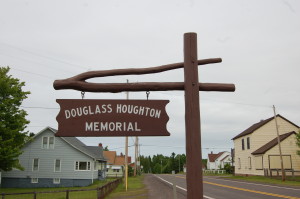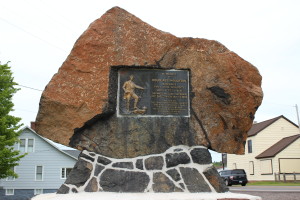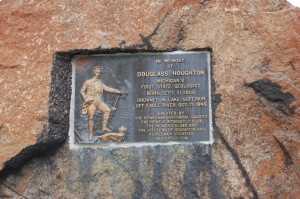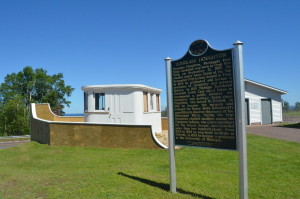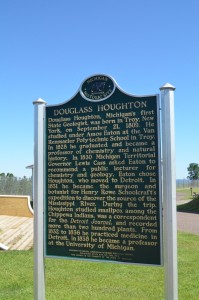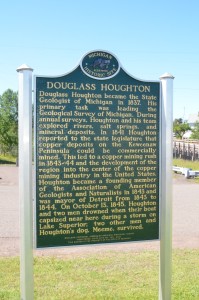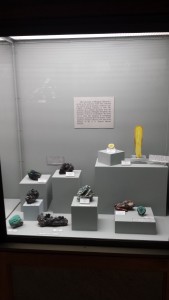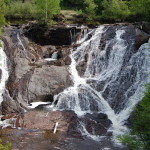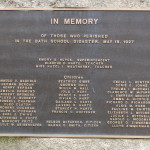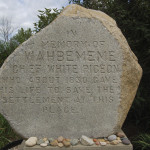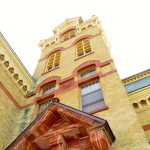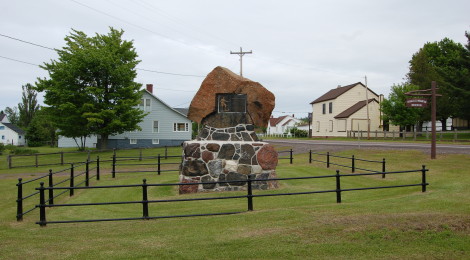
Michigan Roadside Attractions: Douglass Houghton Memorial, Eagle River
Today’s Michigan Roadside Attraction actually covers two different spots in Eagle River that honor Douglass Houghton, our first state geologist and the namesake of Houghton, Houghton County, Douglass Houghton Falls and more. The first site features a memorial plaque on a rock, easily accessible from M-26. The second site features a new Michigan historic marker in front of the Eagle River Museum (also located on M-26). I have no idea why the marker wasn’t placed at the already-existing memorial. Today we’ll tell you how to visit the Douglass Houghton Memorial, and provide some background on his contributions to the history of the Keweenaw Peninsula and beyond.
The Douglass Houghton Memorial can be found at the corner of M-26 and W. Main St. This memorial is made up of stones from various Upper Peninsula copper and iron mines, and it dates back to 1914.
The plaque on this memorial gives Houghton’s birth and death dates, and notes the efforts of the Keweenaw Historical Society, the Home Fortnightly Clubs, the Women’s Clubs and the Citizens of Houghton and Keweenaw Counties in making it possible.
The new Michigan historical marker honoring Douglass Houghton can be found at the intersection of M-26 and 4th St. There is parking available here at the viewing area for Eagle River Falls and the historic Lake Shore Drive Bridge.
The marker’s text is two-sided, first giving details of Houghton’s early life: “Douglass Houghton, Michigan’s first State Geologist, was born in Troy, New York, on September 21, 1809. He studied under Amos Eaton at the Van Rensselaer Polytechnic School in Troy. In 1828 he graduated and became a professor of chemistry and natural history. In 1830 Michigan Territorial Governor Lewis Cass asked Eaton to recommend a public lecturer for chemistry and geology. Eaton chose Houghton, who moved to Detroit. In 1831 he became the surgeon for Henry Rowe Schoolcraft’s expedition to discover the source of the Mississippi River. During the trip, Houghton studied smallpox among the Chippewa Indians, was a correspondent for the Detroit Journal, and recorded more than two hundred plants. From 1832 to 1836 he practiced medicine in Detroit. In 1836 he became a professor at the University of Michigan.”
The second side continues, looking at the years of his life that had the biggest impact on the Keweenaw area: “Douglass Houghton became the State Geologist of Michigan in 1837. His primary task was leading the Geological Survey of Michigan. During annual surveys, Houghton and his team explored rivers, salt springs, and mineral deposits. In 1841 Houghton reported to the state legislature that copper deposits on the Keweenaw Peninsula could be commercially mined. This led to a copper mining rush in 1843-44 and the development of the region into the center of the copper mining industry in the United States. Houghton became a founding member of the Association of American Geologists and Naturalists in 1843 and was mayor of Detroit from 1843 to 1844. On October 13, 1845, Houghton and two men drowned when their boat capsized near here during a storm on Lake Superior: two other men and Houghton’s dog, Meeme, survived.”
Last year we were able to see a few specimens from Houghton’s personal collection at the A. E. Seaman Mineral Museum on the campus of Michigan Tech in Houghton. Though he died here near Eagle River, he was buried at Elmwood Cemetery in Detroit. Though his life was short, his contributions to the state and especially the Upper Peninsula were incredibly important. If you find yourself driving through Eagle River, take a moment to visit the Douglass Houghton Memorial, a great tribute to Michigan’s first state geologist.

